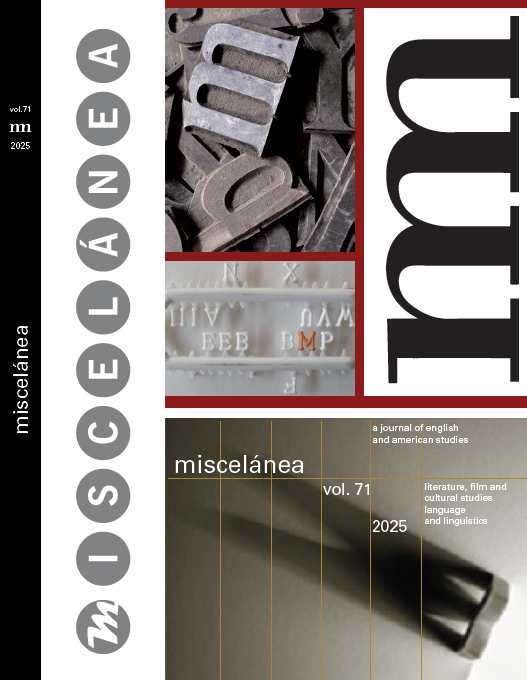Aprendizaje internacional colaborativo en línea entre estudiantado español y ucraniano: Nuevas tareas y nuevas relaciones
DOI:
https://doi.org/10.26754/ojs_misc/mj.202511126Palabras clave:
aprendizaje colaborativo internacional en línea, enseñanza colaborativa en línea , herramientas informáticas, competencia intercultural, percepción del aprendizaje por los estudiantesResumen
Actualmente, nuestra vida profesional se enfrenta a retos que inevitablemente requieren una rápida reacción y un cambio en la educación. Además, la globalización, y la guerra en curso en Ucrania, motivan al profesorado a buscar nuevas oportunidades para la comunicación intercultural. Esta investigación pretende analizar los efectos que produce en el estudiantado una experiencia de aprendizaje internacional colaborativo en línea (COIL por sus siglas en inglés). Los participantes en el estudio fueron 12 estudiantes ucranianos de la Taras Shevchenko National University of Kyiv (Ucrania) de una asignatura de Inglés Académico en el cuarto curso del programa de Lenguas, Literatura y Traducción, y 20 estudiantes españoles de la Universitat Jaume I matriculados en Inglés para los Negocios en el quinto curso del doble grado de Administración de Empresas y Derecho. La metodología constó de tres fases. En primer lugar, los participantes se comunicaron en línea para establecer un primer contacto. En segundo lugar, debatieron sobre sostenibilidad corporativa en Zoom. En tercer lugar, cada grupo redactó un ensayo de opinión en colaboración. Los resultados confirmaron que, a pesar de las dificultades debidas a la guerra en Ucrania, la percepción del estudiantado sobre su experiencia con COIL fue positiva. Estuvieron más motivados e indicaron que esta actividad les había ayudado a mejorar sus destrezas orales y escritas, y su competencia intercultural.
Descargas
Referencias
BELZ, Julie A. and Steven L. THORNE. 2006. “Introduction: Internet-mediated Intercultural Foreign Language Education”. In Belz, Julie A. and Steven L. Thorne (eds.) Internet-Mediated Intercultural Foreign Language Education. Heinle and Heinle: viii-xxv.
Center for Innovation in Teaching and Learning. 2017. COIL (Collaborative Online International Learning). https://www.youtube.com/watch?v=dCmkMOSLjjc&t=3798s. Accessed October 15, 2022.
ÇIFTÇI, Emrullah Yasin and Perihan SAVAŞ. 2018. “The Role of Telecollaboration in Language and Intercultural Learning: A Synthesis of Studies Published between 2010 and 2015”. ReCALL 30 (3): 278-298. http://doi.org/10.1017/S0958344017000313 DOI: https://doi.org/10.1017/S0958344017000313
CRABTREE, Robbin D., David Alan SAPP, José Alfonso MALESPÍN and Gonzalo NORORI. 2008. “Realizing the University Mission in Partnership with Nicaragua: Internationalization, Diversity, and Social Justice”. In Starke-Meyerring, Doreen and Melanie Wilson (eds.) Designing Globally Networked Learning Environments: Visionary Partnerships, Policies, and Pedagogies. Sense Publications: 88-103. DOI: 10.1163/9789087904753_007. DOI: https://doi.org/10.1163/9789087904753_007
CRUZ, Barbara C. 1998. “Global Education in the Middle School Curriculum: An Interdisciplinary Perspective”. Middle School Journal 30 (2): 26-31. https://doi.org/10.1080/00940771.1998.11494570. DOI: https://doi.org/10.1080/00940771.1998.11494570
HACKETT, Simone, Jerooen JANSSEN, Pamela BEACH, Melanie PERREAULT, Jos BEELEN and Jan van TARTWIJK. 2023. “The Effectiveness of Collaborative Online International Learning (COIL) on Intercultural Competence Development in Higher Education”. International Journal of Educational Technology in Higher Education (20) 5. https://doi.org/10.1186/s41239-022-00373-3 DOI: https://doi.org/10.1186/s41239-022-00373-3
KING DE RAMIREZ, Carmen. 2019. “Global Citizenship Education through Collaborative Online International Learning in the Borderlands: A Case of the Arizona-Sonora Megaregion”. Journal of Studies in International Education 25 (1): 1-17. https://doi.org/10.1177/1028315319888886. DOI: https://doi.org/10.1177/1028315319888886
LEE, Lina and Alfred MARKEY. 2014. “A Study of Learners’ Perceptions of Online Intercultural Exchange through Web 2.0 Technologies”. ReCALL 26 (3): 281-297. https://doi.org/10.1017/S0958344014000111. DOI: https://doi.org/10.1017/S0958344014000111
MARGINSON, Simon and Erlenawati SAWIR. 2011. Ideas for Intercultural Education. Palgrave Macmillan. https://dio.org/ 10.1057/9780230339736. DOI: https://doi.org/10.1057/9780230339736
MARULL, Crystal and Swapna KUMAR. 2020. “Authentic Language Learning through Telecollaboration in Online Courses”. Tech Trends 64: 628-635. https://doi.org/10.1007/s11528-020-00488-2 DOI: https://doi.org/10.1007/s11528-020-00488-2
MCNAIR, Lisa D. and Marie C. PARETTI. 2010. “Activity Theory, Speech Acts, and the ‘Doctrine of Infelicity’ Connecting Language and Technology in Globally Networked Learning Environments”. Journal of Business and Technical Communication 24 (3): 323-357. https://doi.org/10.1177/1050651910363275 DOI: https://doi.org/10.1177/1050651910363275
MICHIE, Jonathan. 2018. “Forms of Globalisation: From ‘Capitalism Unleashed’ to a Global Green New Deal”. European Journal of Economics and Economic Policies 15 (2): 163-173. https://doi.org/10.4337/ejeep.2018.02.08. DOI: https://doi.org/10.4337/ejeep.2018.02.08
MONTIEL, Ivan and Javier DELGADO-CEBALLOS. 2014. “Defining and Measuring Corporate Sustainability: Are We There Yet?”. Organization and Environment 7 (2): 113-139. https://doi.org/10.1177/1086026614526413 DOI: https://doi.org/10.1177/1086026614526413
NGUYEN, Nancy Dieu-Ngoc, Alex Ho-Cheong LEUNG, Ho-Thi HIEN and Nguyen-Thi THIET. 2024. “The Impact of Virtual Exchanges Using English as a Lingua Franca on Students’ Linguistic and Intercultural Competence”. TESL-EJ 28 (3) https://doi.org/10.55593/ej.28111a1 DOI: https://doi.org/10.55593/ej.28111a1
O’DOWD, Robert. 2016. “Emerging Trends and New Directions in Telecollaborative Learning”. Calico Journal 33 (3): 291-310. https://doi.org/10.1558/cj.v33i3.30747. DOI: https://doi.org/10.1558/cj.v33i3.30747
O’DOWD, Robert. 2018. “From Telecollaboration to Virtual Exchange: State-of-the-Art and the Role of UNICollaboration in Moving Forward”. Journal of Virtual Exchange 1: 1-23. https://doi.org/10.14705/rpnet.2018.jve.1. DOI: https://doi.org/10.14705/rpnet.2018.jve.1
O’ROURKE, Breffni. 2007. “Models of Telecollaboration (1): E (Tandem)”. In O’Dowd, Robert (ed.) Online Intercultural Exchange: An Introduction for Foreign Language Teachers. Multilingual Matters: 41-62. https://doi.org/10.21832/9781847690104. DOI: https://doi.org/10.2307/jj.27710864.7
ORSINI-JONES, Marina and Fiona LEE. 2018. “The CoCo Telecollaborative Project: Internationalisation at Home to Foster Global Citizenship Competences”. In Intercultural Communicative Competence for Global Citizenship. Palgrave Macmillan: 39-52. https://doi.org/10.1057/978-1-137-58103-7_4 DOI: https://doi.org/10.1057/978-1-137-58103-7_4
RUBIN, Jon and Melanie WILSON. (n.d.). Faculty Guide for Collaborative Online International Learning. Course Development. https://www.ufic.ufl.edu/uap/forms/coil_guide.pdf
RZHEVSKAYA, Nataliia, Irina DOBROSKOK and Darina ZAIMOVA. 2020. “Networking Tools in Virtual Exchange for Cooperation at Universities in Bulgaria and Ukraine”. Information Technologies and Learning Tools 76 (2): 187-197. https://doi.org/ 10.33407/itlt.v76i2.3068. DOI: https://doi.org/10.33407/itlt.v76i2.3068
SONNENWALD, Diane H., Jeffrey IIVONEN, Mirja J. ALPI and Heli KOKKINEN. 1999. “Collaborative Learning Using Collaboration Technology: Report from the Field”. In Eurelings, Anneke, F. Gastkemper, Piet Kommers, Ramon Lewis, Roy van Meel and B. Melief (eds.) Integrating Information and Communications Technology to Higher Education. Kluwer Academic: 241-258. http://eprints.rclis.org/7989/1/1999-book-chapter.pdf
TELLES, Joao and Paola LEONE. 2016. “The Teletandem Network”. In O’Dowd, Robert and Tim Lewis (eds.) Online Intercultural Exchange: Policy, Pedagogy, Practice. Routledge: 273-298.
Descargas
Publicado
Número
Sección
Licencia
Derechos de autor 2025 Inmaculada Fortanet-Gómez, Viktoriia Drobotun

Esta obra está bajo una licencia internacional Creative Commons Atribución-NoComercial 4.0.


